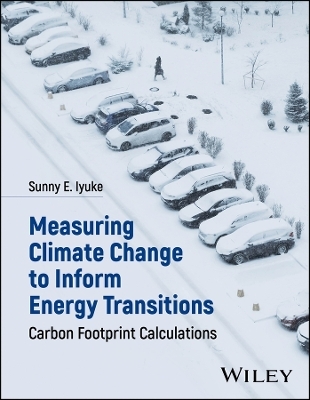
Measuring Climate Change to Inform Energy Transitions
John Wiley & Sons Inc (Verlag)
978-1-394-20731-2 (ISBN)
Climate change is without question the greatest global challenge of the twenty-first century. Among its many aspects is the need for energy transitions worldwide, as sustainable energy infrastructure must be rapidly created if the world is to forestall climate catastrophe. Methods for measuring CO2 concentration and other factors producing climate change will be critical to managing this transition and assessing its early impacts.
Measuring Climate Change to Inform Energy Transitions proposes a method for measuring sinusoidal gradients of increasing temperatures and CO2 concentration in order to determine the ongoing impact of global warming and make recommendations. This method will be critical in informing key decisions as the energy transition proceeds. It is a must-read for academic, professional, and policy stakeholders looking to meet these challenges head-on.
Readers will also find:
Concrete models and mechanisms for effecting energy transition
Detailed discussion of topics including vegetative sinks for carbon capture, power reforms from coal, carbon footprint of internal combustion engines, skills required for green jobs and many more
Examples and case studies to supplement quantitative analyses
This book is ideal for professionals, undergraduate and graduate students, and researchers in the energy, environmental, government, and engineering fields.
Sunny E. Iyuke, PhD, MSc, BSc, is a full professor of Chemical and Process Engineering at the University of the Witwatersrand (Wits) in Johannesburg since 2005. He obtained his PhD in Chemical and Process Engineering in 1999. He has generated more than $40 million to support his research and training since 2001, and as Principal & Chief Executive Officer at the Petroleum Training Institute in Warri, Nigeria (2016-2020), he raised $11 million to support capital projects and research, which led into the establishment of the Directorates of Research and Library & Information Technology in the Institute. He is a chartered Engineer with the Engineering Council of UK, Professional Engineer with the Engineering Council of South Africa, Registered Engineer with the Council for the Regulation of Engineering in Nigeria (COREN), a Fellow of South African Academy of Engineering and a Fellow of the Nigerian Society of Chemical Engineers.
Preface xiii
1 Introduction, Carbon Footprint and Climate Change 1
1.1 Introduction 1
1.2 GlobalWarming Due to Carbon-Cycle Feedbacks in a Coupled Climate Model 2
1.3 A Mathematical Model of Man-Made CO2 Emissions 3
1.4 Estimation of GlobalWarming for Energy Transition 5
1.5 Conclusion and Future Direction 10
2 Vegetative Sinks for Carbon Capture 13
2.1 Plant Agricultural Practices as Carbon Dioxide Sink 13
2.2 Microalgae as a Biological Capture for CO2 16
2.3 Cultivation and Adaptation of Microalgal Communities to 100% Coal-Fired Flue Gas 17
2.4 Status of Food System, Food Insecurity and Climate Change 19
2.5 A Case Study: Student Food Garden at theWits University 21
2.6 Biomass Towards Extended Carbon Storage and CO2 Capture 36
3 Carbon Transition for the Petrochemical Sector 39
3.1 Carbon Intensity of Global Crude Oil Refining 39
3.2 GHG Reduction Measures for the Petroleum Refining Industry 41
3.3 Measure and Comparison of Carbon Capture Methods 43
3.4 Benefits of Modular Refinery Design and Construction 45
3.5 A Case Study: Design Report of Modular Refinery at Wits University 45
4 Energy Transition and Power Reforms from Coal 137
4.1 Planning for a Just Carbon Transition 138
4.2 Coal Gasification and DME Production 139
4.3 A Case Study: Balance of Plant Design for Simultaneous DME and Methanol Production, and Power Generation atWits University 140
4.4 Conclusion 190
5 Carbon Footprint of Internal Combustion Engines and Mitigations 194
5.1 Internal Combustion Engine and Emission 194
5.2 Component Production: PEM Fuel Cell and Electrolyser 196
5.3 Process Design and Integration of PEM Electrolyser and Fuel Cell 204
5.4 Component Production: Platinum Group Metal Recovery fromWaste Automotive Catalytic Converter for PEM Fuel Cell Technology (Case Study 3) 221
6 Application of Carbon Footprint to Climate Change Solutions 234
6.1 Renewable Energy Consumption and Economic Growth 235
6.2 Pyrolysis to Convert SolidWaste into Useful Energy 236
6.3 Factors Affecting Pyrolysis of Used Tyres and Plastics with Respect to Products 237
6.4 Case Study: Production and Characterisation of Biocrude from Used Tyres and Natural Rubber 239
6.5 Concluding Remarks and Recommendations 299
7 Climate Change Policy and Skills Education 309
7.1 Case Study -- Five-Year Review of Skills Training and Education in a Chemical and Metallurgical Engineering Curriculum 311
7.2 Information with Respect to Activities 318
7.3 Finance 320
7.4 Teaching in the School 324
7.5 Effect of Skills Training and Education Policies on Climate Change 327
References 333
Notation 335
Index 339
| Erscheinungsdatum | 19.03.2024 |
|---|---|
| Verlagsort | New York |
| Sprache | englisch |
| Gewicht | 1424 g |
| Themenwelt | Naturwissenschaften ► Chemie ► Technische Chemie |
| Technik | |
| ISBN-10 | 1-394-20731-X / 139420731X |
| ISBN-13 | 978-1-394-20731-2 / 9781394207312 |
| Zustand | Neuware |
| Informationen gemäß Produktsicherheitsverordnung (GPSR) | |
| Haben Sie eine Frage zum Produkt? |
aus dem Bereich


